
FAQs About Aloe Arborescens
As a passionate plant enthusiast, I’ve spent a lot of time with Aloe Arborescens and have gathered a range of insights about this fascinating plant. In this article, I’ll address some frequently asked questions about Aloe Arborescens, also known as the Torch Aloe, to help you understand its characteristics, care, and uses.
605 Species in Genus Aloe
What is Aloe Arborescens?
Aloe Arborescens is a succulent plant native to Madagascar and various parts of Africa. Unlike its more well-known relative, Aloe Vera, Aloe Arborescens is a larger plant, often growing up to 10 feet tall. It has a tree-like form with a thick, branching stem and rosettes of spiky, gray-green leaves. These leaves can have a reddish tinge and are often covered in small, white spots.
Where to Buy Aloe Arborescens?
You can buy Aloe Arborescens from various sources. Nurseries specializing in succulents or cacti are good places to start. Online retailers like Amazon and specialty plant shops also offer Aloe Arborescens. If you’re lucky, you might find it at a local farmer’s market or a plant swap event.
How to Identify Aloe Arborescens?
To identify Aloe Arborescens, look for its distinctive features. The plant has a tree-like growth habit with a thick, woody trunk and a rosette of long, lance-shaped leaves at the top. The leaves are usually gray-green with small white spots. During the winter months, Aloe Arborescens produces tall flower spikes with tubular, red or orange flowers.
How to Care for Aloe Arborescens?
Caring for Aloe Arborescens is relatively straightforward. Here are some essential tips:
- Light: Aloe Arborescens prefers bright, indirect light but can tolerate some direct sunlight. It thrives in sunny indoor spots or outdoor locations with partial shade.
- Watering: Water the plant thoroughly but infrequently. Allow the soil to dry out between waterings to prevent root rot. In the winter, reduce watering.
- Soil: Use well-draining soil, such as a cactus or succulent mix. Good drainage is crucial to prevent overwatering issues.
- Temperature: Aloe Arborescens prefers temperatures between 50°F and 80°F. Protect it from frost and extreme heat.
How to Grow Aloe Arborescens from Seed?
Growing Aloe Arborescens from seed requires patience. Here’s a basic guide:
- Prepare the Seeds: Soak the seeds in water for 24 hours to improve germination.
- Planting: Sow the seeds in a seed tray filled with a well-draining seed mix. Lightly cover the seeds with soil.
- Germination: Keep the soil moist but not waterlogged. Place the tray in a warm, bright location with indirect light.
- Transplanting: Once the seedlings have developed a few sets of leaves and are large enough to handle, transplant them into individual pots.
How to Make Aloe Arborescens Juice?
Making Aloe Arborescens juice is simple. Here’s a step-by-step guide:
- Harvest: Cut a few mature leaves from the plant.
- Prepare: Wash the leaves thoroughly and peel off the outer skin to expose the gel.
- Blend: Scoop the gel into a blender and blend until smooth.
- Strain: Strain the mixture through a fine mesh sieve or cheesecloth to remove any remaining pulp.
- Store: Store the juice in an airtight container in the refrigerator. Consume it within a week for the best freshness.
How to Propagate Aloe Arborescens?
Propagating Aloe Arborescens can be done through offsets or cuttings. Here’s how:
- Offsets: Look for small plantlets (pups) at the base of the mature plant. Gently separate them from the main plant and pot them up in a new container.
- Cuttings: Take a healthy leaf cutting and let it callus over for a few days. Plant the cutting in a well-draining potting mix and water sparingly until roots develop.
How to Use Aloe Arborescens?
Aloe Arborescens has various uses, including:
- Medicinal: The gel from Aloe Arborescens is used for its soothing and healing properties. It can be applied topically to minor burns, cuts, and skin irritations.
- Juice: The juice can be consumed for its potential health benefits, including digestive support and immune system enhancement.
- Ornamental: Aloe Arborescens makes an attractive addition to gardens and indoor plant collections due to its striking appearance.
Is Aloe Arborescens Edible?
Aloe Arborescens is edible, but it is not as commonly used as Aloe Vera. The gel can be consumed in small amounts, but be sure to use it in moderation and consult a healthcare professional if you have any health concerns.
Is Aloe Arborescens Toxic?
Aloe Arborescens is generally not considered toxic. However, the sap from the plant can cause mild irritation if it comes into contact with the skin or eyes. Always handle the plant with care and wash your hands after handling it.
What is the Difference Between Aloe Vera and Aloe Arborescens?
While both Aloe Vera and Aloe Arborescens belong to the Aloe genus, they have distinct differences:
- Size and Growth: Aloe Vera is smaller and typically grows up to 3 feet tall, whereas Aloe Arborescens can reach up to 10 feet.
- Appearance: Aloe Vera has shorter, wider leaves and lacks the tree-like structure of Aloe Arborescens.
- Uses: Aloe Vera is widely used in skincare products, while Aloe Arborescens is often used for its medicinal properties and as an ornamental plant.
Aloe Arborescens vs Aloe Barbadensis
Aloe Barbadensis is another name for Aloe Vera. The primary differences between Aloe Arborescens and Aloe Barbadensis are their size, growth habit, and typical uses. Aloe Vera is smaller, more common in commercial products, and has broader leaves compared to the more tree-like Aloe Arborescens.
Aloe Arborescens vs Aloe Ferox
Aloe Ferox, also known as Cape Aloe, is similar to Aloe Arborescens but has a more robust appearance with thicker, more rigid leaves. Aloe Ferox is often used for its bitter latex in medicinal applications, while Aloe Arborescens is prized for its gel and ornamental value.
Can You Grow Aloe Arborescens Indoors?
Yes, you can grow Aloe Arborescens indoors. It requires bright, indirect light and a well-draining potting mix. Be mindful of indoor temperature and humidity levels to keep the plant healthy.
Benefits and Common Problems
Aloe Arborescens offers several benefits, including its ornamental value and potential medicinal uses. Common problems include overwatering, which can lead to root rot, and pest infestations like mealybugs or aphids.
By understanding these aspects of Aloe Arborescens, you can better care for this remarkable plant and make the most of its unique qualities.
If i die, water my plants!



